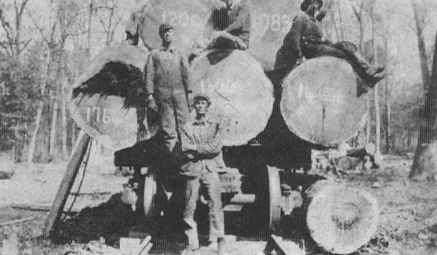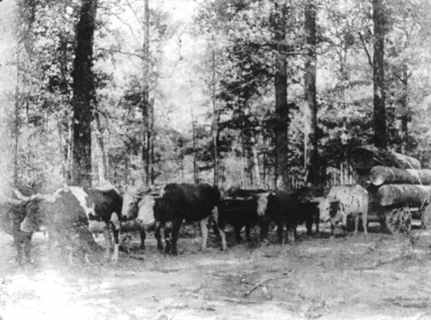Page 10
![]() Seite 11 / page 11 of
24
Seite 11 / page 11 of
24
![]() zurück / back home
zurück / back home
Timber Industry Makes Its Mark
Several Companies Followed "Cut Out - Get Out" Policy
| At the time the railroad was located in Cleveland County, the area was covered with vast stands of virgin pine, oak, hickory, gum and cypress timber. The completion of the railroad allowed a method of transportation to get the lumber to national markets. Prior to the 1880's there was no efficient method to market the products of mills. After the railroad was completed many companies came to the area and established offices in Rison with the mill sites located outside the city. Several of the larger mills included the J.I. Porter Lumber Company, Kendal Lumber Company, Sallee and Ray Sawmill, Emerson Sawmill, (Uland Sawmill, Saline River Shingle and Lumber Company. The larger lumber companies |

OXEN TEAM - Oxen were frequently used in the early days to pull timber from the surrounding cut sites to the mills in Rison. |
| followed a "cut out" and followed a "cut out" and "get out" policy and moved on when their holdings of timber were exhau- sted. Typically they would lease for a period of 20 - 25 years and then move on when mill machinery began to wear out. However, some of the smaller |
companies were locally owned and continued to operate in the area for many years cutting and selling "second growth" timber. Some of the locally owned companies were: Choellmire and Emerson, Buster and Griffith Lumber Company, |
Dave Cash, Robertson and Ray, Bert England, England and Tate, Gamer and Knowles, C. L. Gamer and Sons, Davis and Sadler, J. F. Doster, J. L. Williams, W. D. England, Home-Gray Lumber Com- pany, Anthony-Williams, and Rison Lumber operators included: W. S. Amis, F. W. |

TIMBER AND THE RAILROAD - Not long after the railroad arrived at Rison, several spur lines sprang up around the area that made it much easier and faster for companies to haul the massive timber from the cut sites to the mills at Rison and elsewhere around the county. |
Culpepper, Charles L. Walker and J. L. Sadler. The Clio Lumber Company, which was begun in 1889, was located five miles north of Rison on the Cotton Belt at a small community named Clio. It was s subsidiary of the Bluff City Lumber Company of Pine Bluff. The Clio Mill was an exemplary milling operation that was given extensive coverage in 1909 in the American Lumberman Maga- zine, a prestigious industry publication. At that time the mill owned several thousand acres of timberland which amounted to several million board feet of lumber. In 1909 the mill had 640 employees including 432 men |
![]() Seite 11 / page 11 of
24
Seite 11 / page 11 of
24
![]() page
1
page
1
![]() 2
2
![]() Index
Index
![]() 3
3
![]() 4
4
![]() 5
5
![]() 6
6
![]() 7
7
![]() 8
8
![]() 9
9
![]() 10
10
![]() 11
11
![]() 12
12
![]() 13
13
![]() 14
14
![]() 15
15
![]() 16
16
![]() 17
17
![]() 18
18
![]() 19
19
![]() 20
20
![]() 21
21
![]() 22
22
![]() 23
23
![]() 24
24
![]() zurück / back home
zurück / back home